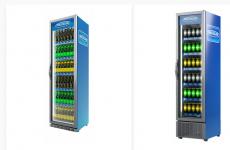How to cool bridges on the motherboard. The bridge on the motherboard is heating up. A universal solution for everyone
Previously, I recommended purchasing boards that did not have any additional gadgets for cooling the northbridge of the chipset, because most often this indicated a “correct”, competent design.
However, now the trends have changed, and northbridge cooling has become the norm.
Alas...
Therefore, we must try to evaluate the degree of efficiency of the northbridge cooling system, because since it is present, then let it be effective: “you can’t spoil the porridge with oil.”
What useful information can we obtain by visual inspection?
There are not so few of them...
I never recommend boards to anyone that have active cooling (radiator + fan) on the northbridge chip.
Source of negative information: personal experience.
Let the manufacturing companies forgive me, but I don’t believe that they install expensive and reliable fans.
But a cheap and simple one will become clogged with dust and die after a year of active computer operation.
Further: it should be understood that a radiator with a stopped fan on top is even worse than a radiator without a fan at all.
This is probably where we’ll finish with the question of active cooling of the north bridge...
Photo 3. It cools quite well... While it works...
Preference should be given to fairly high “needle” radiators.
In the absence of a fan (we have already discussed why it is better that there is no fan), this design of the radiator ensures the most efficient cooling by air flows inside the case.
Photo 4. The most “correct” radiator: proper mounting, good high “needles”.
Tall "plate" radiators are less preferred, even if their plates are quite narrow and there are many of them.
Why?
Yes, simply because air flows blowing “across” the plane of the plates will cool them much worse.
Of course, you can say that the flows can be directed in the desired direction.
One question: will you be doing any research on air flow inside your computer case?
You don't have to answer...
Photo 5. The fastening is good, but the shape is not ideal.
The worst options of all are small flat “plate” radiators, or radiators with very short “needles”, as well as the overwhelming number of “designer and decoration” solutions.
I think that those who have read the points in the previous paragraphs no longer need to explain why.
In fact, such a radiator is 70% (this is the mildest estimate) a complete sham.
He is only able to compensate a little instantaneous short-term heating, but it will not save the chip from the consequences of constant overheating.
Photo 6. A wonderful, beautiful design element.
It has very little to do with cooling. One good thing is that this is the south bridge after all.
The method of fastening can tell a lot about who the manufacturer thinks we are.
If you see special “clamps” for the radiator on the board (their two main varieties are shown in photos 4 and 5 above), this is highly likely to indicate that there is thermal paste between the chip and the radiator.
In this case, fastening is necessary for the simple reason that thermal paste cannot hold the heatsink on the chip, and that’s not its purpose.
If the radiator does not have a mount (photo 7), then with almost 100% probability we can say that it is glued to the chip.
And with a 90% degree of probability it is glued with adhesive plastic tape, the thermal conductivity of which is very far from even the most mediocre thermal paste.
At best, this means that the cooling capacity of such a radiator is artificially reduced (precisely due to the mounting method).
In the worst case (which is not that rare), this means that such a radiator is a complete sham.
Photo 7. No fastening is observed, which means that the radiator is almost certainly glued.
“Twist” it by holding the sides with your fingers.
If it turns a little, it's plastic Velcro, no doubt.
As you can see, even a visual inspection of the northbridge cooling system can tell us quite a lot.
It only remains to add that more efficient cooling in general increases the “safety margin” of the board (although, of course, the bottleneck may not be here at all).
But it doesn’t reduce it in any way, that’s for sure.
AMD Radeon Software Adrenalin Edition 19.9.2 Optional Driver
The new AMD Radeon Software Adrenalin Edition 19.9.2 Optional driver improves performance in Borderlands 3 and adds support for Radeon Image Sharpening technology.
Windows 10 Cumulative Update 1903 KB4515384 (Added)
On September 10, 2019, Microsoft released a cumulative update for Windows 10 version 1903 - KB4515384 with a number of security improvements and a fix for a bug that broke Windows Search and caused high CPU usage.
Modification of the cooling system on the ASUS P5B Deluxe/WiFi-AP motherboard.
This short review is devoted to modification (improvement) of the cooling system on the ASUS P5B Deluxe/WiFi-AP motherboard. Improving the cooling system only makes sense if you want to overclock your processor well, i.e. if you don’t plan to overclock the processor at all (then why buy such an expensive motherboard?), then you don’t need to read this article and don’t improve the cooling system, since without overclocking the motherboard works very stably and doesn’t need to change anything! I bought this particular motherboard because after reading many reviews and tests, including foreign ones, I realized that, in my opinion, this is currently one of the best motherboards for overclocking Intel Core 2 Duo processors. Even the fact that it is on this motherboard that new quad-core Intel processors of the Kentsfield family are tested and overclocked speaks volumes. By the way, to support new quad-core processors with this motherboard, you just need to update the BIOS to version 0706 and later.
Let's move on directly to improving the cooling system of the ASUS P5B Deluxe/WiFi-AP motherboard.
1) Replacing the thermal interface on the north and south bridges.
The first thing I decided to do when I took the motherboard out of the box was to remove the heatsinks from the north and south bridges, clean off the factory thermal paste from them, and also clean off the thermal paste from the north and south bridge chips.
To do this, we will need several cotton swabs, some ethyl or isopropyl alcohol, tweezers and a flat-head screwdriver.
Turning the motherboard over, we will see that the south bridge radiator is attached to it with two clamps, we can safely press them out with tweezers and carefully remove the radiator. It may not be easy to remove, since it is most likely stuck tightly to the south bridge chip. To remove it, you either need to apply a little force, but only carefully, or pick up the heatsink with a screwdriver and unstick it with it, but again everything must be done carefully so as not to damage the contacts and microcircuits on the motherboard! You absolutely also need to do everything with the northbridge heatsink, but you need to take into account that a heat pipe goes from it to the mosfets, which connects to another heatsink and this whole system is removed together, that is, you need to be even more careful there!
After we have removed the radiators from the north and south bridges, we need to remove the factory thermal paste from them. To do this, take a cotton swab, moisten it in ethyl or isopropyl alcohol and remove the paste from the radiators. This may take some time and you will have to change more than one cotton swab, since the factory thermal paste has dried quite strongly to the radiator.
Next, if your radiators are more or less even and well sanded, then you don’t need to do anything else with them, but if they are poorly sanded and not very even, then you can level their base using sandpaper, and then sand it using GOI paste and oils (the corresponding methods are on the forum and I will not present them here).
Now you need to remove the thermal paste from the south and north bridge chips. To do this, use a cotton swab pre-soaked in alcohol to carefully wash off the factory thermal paste; do this slowly, so as not to damage the chips themselves and other microcircuits of the motherboard.
After we have freed the radiators and north and south bridge chips from the factory thermal paste, we need to apply some other more effective thermal paste. For this purpose, I chose the most affordable, and, in my opinion, very good price/availability/thermal conductivity ratio, KPT-8 thermal paste, purchased at Sunrise in mid-September 2006. The paste was in a 125-gram tube, it was white in color and had a slightly thick consistency; by the way, its shelf life indicated on the tube was 3 years.
Squeeze a small drop of KPT-8 thermal paste onto the south bridge and spread it over the entire surface of the chip in an even thin layer. I smeared the drop with the help of a fingertip, quite conveniently I must say. You should also apply a very small drop of thermal paste to the south bridge radiator itself to avoid the formation of air bubbles from possible unevenness or roughness of the radiator. Next, carefully press the heatsink onto the south bridge chip and snap it onto the back of the motherboard. On the north bridge we do everything similarly to the south bridge, except that the north bridge chip is smaller and correspondingly less thermal paste is needed. Don’t forget to also apply just a little tempopaste to the northbridge radiator.
The thermal interface on the north and south bridge of the ASUS P5B Deluxe/WiFi-AP motherboard has been replaced.
In principle, we could stop here, but for those who plan to push the processor very hard and may need to increase the voltage on the north and south bridges, as a result of this they will begin to get very hot. Moreover, in normal mode, even without replacing the thermal interface, the north and especially south bridges get very hot. Without replacing the thermal interface and even without overclocking, the temperature on the south bridge was up to 50-55 degrees during long-term computer games. The North Bridge initially heats up less, since it has a more massive radiator. But in order to improve the processor overclocking performance when the voltage on the north and south bridges increases, as well as to properly cool the north and south bridges, we proceed to the second part of improving the cooling system on the ASUS P5B Deluxe/WiFi-AP motherboard.
2) Additional cooling of the north and south bridges.
I probably went with the simplest method of additional cooling of the chipset and south bridge.
I glued 4 radiators onto the south bridge, designed to cool the memory of the video card from the Titan kit. I used Alsil-5 thermal conductive glue as glue.

We are done with the south bridge and now we can start improving the cooling of the north bridge (chipset).
I glued a radiator with a fan from the same kit for cooling the Titan video adapter onto the north bridge using Alsil-5 thermally conductive glue.

With the installation of additional cooling on the north and south bridge completed, we can now begin installing additional cooling on other parts of the motherboard.
3) Additional cooling of other parts of the motherboard.
The ASUS P5B Deluxe/WiFi-AP motherboard comes with a special additional fan that is placed on the radiator that cools the mosfets. In principle, it is quite sufficient if the system is overclocked.
I had to cool the air space around this radiator in a different way, since installing a Thermaltake Big Typhoon processor cooler does not allow installing this fan, because the Typhoon’s dimensions are large and the heat pipes prevent the installation of an additional fan on the radiator that cools the mosfets.
Using the same Alsil-5 thermal conductive glue, I glued a 40x40 mm Titan TFD 4010M12C fan onto a gigabit network card block - not very beautiful, but so far everything is holding together, not falling off, and most importantly, this fan blows the air space above the radiator, which cools the mosfets .


Next, I decided to cool the 8-phase power supply chips of the RIO R47 processor, which become noticeably hot after several hours of playing computer games. On them I simply glued aluminum radiators from the TITANTTC-CUV2AB RHS rpm video adapter cooling kit.



This completes the modification (improvement) of the cooling system on the ASUS P5B Deluxe/WiFi-AP motherboard. Do not judge the article strictly, as it does not claim to be perfect. All wishes and comments can be sent to me via PM. or by email and also in the topic Asus P5B / P5B-E / Plus / Deluxe / WiFi-AP (Intel P965)
P.S. Happy overclocking everyone.
Nowadays, every second person has a computer. And everyone wants to get more performance for less money. But how to do this? Of course, I’m talking about overclocking/overclocking, a simple example: why buy a higher-frequency processor if you can overclock a younger one to its frequencies. Everything would be wonderful, but there is one “BUT”, this “BUT” is proper cooling of the intra-system space.
How to organize it better? Which system components should I install it on? I will offer you my method of upgrading some computer devices. I did not touch upon processor cooling, since the Internet is full of various comparisons and tests of various coolers. For this reason, I decided to write a guide on how to easily and painlessly upgrade your motherboard and your video. I would also like to say that this article is intended to help beginners and doubters rather than adepts in such a difficult task as overclocking.
I will also provide data about my system (it is 100% stable):
Pentium 4 [email protected] (Step. DO) (264*12) (1.6V) (Northwood)
Zalman CNPC7000Cu (2000rpm)
Kingston DDR400, (2.5/3/3/5) (2.8V) 512 mb*2 (Dual Channel)
Motherboard -Asus P4P800 Gold
Video-ATI Radeon 9800@Pro (324/580@410/710) (3.2ns Samsung)
HDD Maxtor Diamond 9 Plus 160 GB
PSU 300W Powerman
Additional fans: 1-exhaust (80mm), 1-intake (80mm), 1-on the hard drive electronics, on the side 92mm Zalman - all of them are connected via Thermaltake Hardcano 9
WinXP SP2 (build 5100), the system is installed on local drive C, 15GB in size, everything, unnecessary services are disabled.
The temperature of the video card was measured using a thermocouple near the core. The following programs were also used to check the temperature:
Asus PcProbe v2.20.07
Video Drivers - Catalyst 5.1
To warm up the memory and processor - S&M 0.3.2a
To check the video:
The article will consist of several stages:
Upgrading motherboard cooling
Video card upgrade
Motherboard
Today, I865PE/I875P system logic sets are very popular among ordinary users and, of course, overclockers. They have excellent performance and good overclocking potential.
Everyone is familiar with the P4P800 motherboard from Asus. And everything would be good in it, both the design and the overclocking capabilities, but the cooling let us down. On the board it is implemented using a passive cooler, which clearly does not contribute to overclocking. In principle, as a result of the improvements, the stability of the system should increase when operating at a high bus frequency of 285-300 MHz.
On my P4P800 rev.1.02 board this heatsink is silver. I would like to immediately note that when modernizing the guarantee is not lost, subject to direct hands. I am not responsible for damaged boards. Everything that is described here in this article, you do at your own peril and risk.
What we need:
thermal paste KPT-8, Alsil 3
sanitary sticks 3-4 pcs. + alcohol
fan from the Titan TTC-CUV2AB kit for video cards or any other 40*40mm
super glue
paint (silver/black) or not needed at all if the valve is black
wide blade screwdriver
First stage
We remove the motherboard from the case; you also only need to remove the video card and RAM. We need to carefully remove the radiator without touching the motherboard's PCB in order to get rid of the old thermal interface. To do this, take a screwdriver with a wide blade and press the hooks from top to bottom, as shown in Fig. 1:

Under the radiator is the north bridge, in my case covered with a disgusting pink substance. We wash off all this disgrace with the help of hygiene sticks soaked in alcohol or solvent. In its place we apply a thin layer of good thermal paste KPT-8 or any other, fortunately there is plenty to choose from. Also be sure to wipe off any remaining old thermal paste from the back of the heatsink. Now we do the whole operation in reverse, i.e. install the heatsink on the chip.
Second stage
When the radiator is installed in its old place, we can begin installing the fan, but we need to not lose the warranty, how to do this? There is an Asus inscription on the radiator; we paste a thin strip of tape onto it:

Next, we take the fan from the kit for Titan TTC-CUV2AB video cards, initially it is golden in color, of course, this is good, but I wanted it to be the same color as the radiator, i.e. silver color. A can of silver Motip paint was found in the storage room. The valve was immediately repainted a different color. It dried for an hour or an hour and a half. You can either paint the valve or not.

After all this, you take Super Glue and drip a few drops onto the place where the tape is pasted and place a fan on top of it. So, what did we get as a result? The temperature dropped by about 3-5 degrees, and installing additional cooling had a positive effect on overclocking my processor. I managed to raise the bus by another 5 MHz, so now I have 264*4 for a total of 1057 MHz. In practice, we see an increase in speed after simple manipulations. More about testing conditions. After all this, I really wanted to know if the temperature had really dropped that much. To check, the S&M utility was launched for 5 minutes, before and after the upgrade. The table contains data on the temperature of the north bridge and processor. By the way, I wanted to say that my southbridge is not bare; it has a small passive radiator on it, covered with adhesive thermal paste. Actually, here is the diagram:
I think comments are unnecessary. Even a seemingly simple mod can increase overclocking potential and lower temperatures. Now let’s turn our attention to the video card, as another “heating device” in your case.
Replacing the cooling on the ATI RadeOn 9800 @ Pro video card
So, I purchased an ATI Radeon 9800 128MB video card, made by Sapphire, but apparently it was from the first series, so the ATI sticker on the cooler was not even replaced. The board represents a completely reference design from the manufacturer. The only thing that disappointed me was the relatively slow memory with a cycle time of 3.2 ns made by Samsung. Here she is:
The older sister differs from mine in that they usually have faster memory with a response time of 2.8 ns, which ensures operation at 700 MHz.
Thus, the frequencies of the “Pro” version are 378/680 MHz, and mine are 325/580. I think you get my idea? Yes, yes upgrade the 9800 to 9800 PRO. But to do this, you need to upgrade the cooling of the chip and memory, because you won’t get far with native cooling:
One distinctive feature of this cooler is its excellent compression to the core, due to the small bump on its back. Let's not forget that there was a protective frame around the core of the entire older generation of Radeons. It can be easily removed, but then we would lose the warranty, which is extremely undesirable. Where is our experimental processor cooler? This will be GlasialTech Igloo 4100GE for Pentium 4:
A very good cooler, with gold plating, and a quiet fan. It was decided to subject it to light processing and install it on a video card. Light processing is a modification to suit the profile of the video card. Here are some characteristics and data about the experimental cooler:
Maximum Cooled Processor Frequency – Pentium 4 3.0Ghz
Dimensions 83x69x53 mm
Weight (with fan) 357 grams
Thus, we had to trim the radiator on a lathe where the capacitors of the video power system abutted it. The frame, which should, in theory, press the cooler to the central processor, had to be removed and the fan screwed onto self-tapping screws directly between the radiator fins. A thread was also cut on the back of the radiator for two standard holes, and pieces of the radiator were cut here and there for small parts such as capacitors, etc.:
The cooler is pressed perfectly against the video card. The bolts were equipped with rubber gaskets to avoid damage to the PCB. Between the core and the cooler a thin layer of KPT-8 thermal paste was spread. A thermocouple was also installed between the radiator fins and connected to Hardcano. As a result, we get the following monster:
But that’s not all, we still need to install radiators as a keepsake. But where can you get them?
There was no cooler at hand, but there was a silent cooler from Zalman ZM80D-HP, made on two heat pipes. I tried to install it, but personally, it seemed to me ineffective for overclocking, because it played the role of a frying pan in the case, everything was heated from its huge surfaces... But it came with excellent radiators as a souvenir, which I used:
Actually, after all the manipulations done, the card was installed in the AGP slot, without any problems. There was a little worry because of the mass of the cooler, but everything seemed to work out. I overclocked the video with RivaTuner. With the new cooling, the board overclocked perfectly and more than covered the frequencies of its older sister; from the “native” 325/580 MHz it went up to 410/710 MHz. It was decided to flash the BIOS from the Radeon 9800Pro with Samsung 2.8 ns memory. I asked for it. Everything is fine! The drivers recognized the new video card, and I ran several tests and not a single artifact or stripe! Now let's take a look at the temperature of the card when idle and when running tests from the 3D Mark 03/05 package: the temperature of the video card in idle mode is 24°C, when loading - 41°C.
Some results of the 3D Mark 03 (default) benchmark so that we can see the increase from overclocking:
Conclusion
So, as a result of our simple upgrades, we were able to raise computer performance to a new level. Cooling the motherboard helped increase the bus frequency by 5 MHz, and accordingly the processor frequency also increased. We also upgraded the video card, gaining an increase in core overclocking: 26%, memory overclocking: 22%. In addition, now I have a 9800Pro in my case, which cannot but be pleasant
I will be very pleased if this guide helps someone do something new for their computer and improve its performance. Good luck!
P.S. For comparison, I am attaching a photo of the old video card cooler and the new one:
Kibis
23
/02.2005
A fairly common problem is when the computer's south bridge gets very hot. And for nForce-based motherboards, chipset overheating is perhaps the most common cause of failure. We received a system unit based on the ASUS M2N-XE MP. Having launched the AIDA64 program, we saw that the chipset temperature reached 78 degrees:
MCP is a chipset
Many will say, “Well, what’s wrong with that? This is nForce! Yes, the nVidia chipset is a very hot chip and always got quite hot. But the colder it is, the longer it will work.
How to improve chipset (bridge) cooling
Removing the motherboard
The most time-consuming procedure is dismantling the motherboard. But in most cases this must be done in order to remove the radiator. We take out the video card, disconnect the cables and wires, unscrew the 6 bolts that secure the motherboard to the case. On reverse side of the system board, squeeze the fastener tips:

We take out the plastic fasteners themselves and remove the radiator:

Chipset (bridge) mounts
Replacing thermal paste
Now you need to remove the remnants of the old thermal paste from the radiator and chip and degrease them with alcohol. You will then need to apply new paste to the bridge.

and on the radiator:

Installing additional cooling for the chipset
We decided to take this opportunity and attach a 40mm cooler to the radiator for better cooling.

Cooler 40x40x10
We install a radiator with a cooler on the chipset. We snap the fastenings. Now you can screw the motherboard to the case, connect wires, SATA cables and install the video adapter.
The result is excellent: thanks to the fan, the bridge temperature dropped from 78 °C to 49 °C:

The temperature of the nForce chipset has dropped significantly
Thus, we protected the nForce chip from overheating and probably significantly extended the life of the computer as a whole.






